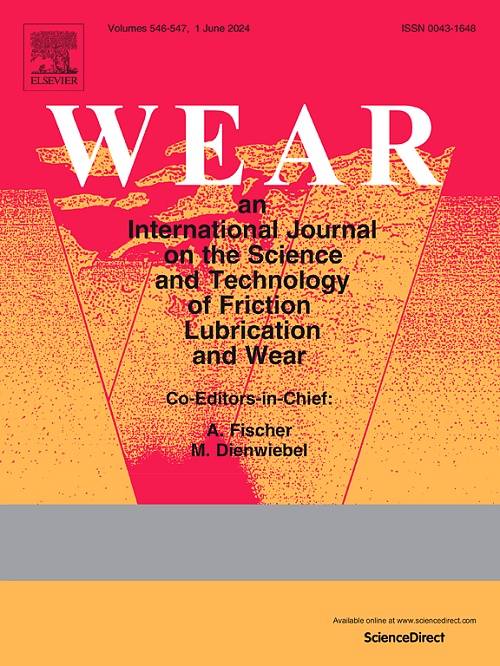Physicochemical and lubricating properties of choline amino acid ionic liquids as neat lubricants for steel-steel contact
IF 6.1
1区 工程技术
Q1 ENGINEERING, MECHANICAL
引用次数: 0
Abstract
The development of high-performance and environmentally-compatible lubricants is crucial for minimizing energy losses in mechanical systems and increasing the lifetime of moving mechanical components, thus preserving our environment. While ionic liquids (ILs) have emerged as promising next-generation materials for lubrication purposes owing to their attractive physico-chemical properties, several challenges currently limit their use in engineering applications, including their high cost and corrosivity. Recently, eco-friendly, protic ILs (PILs) have been synthesized and showed great advantages compared to tradition (aprotic) ILs, such as low cost, ease of preparation, and good lubricating properties. Despite these advancements, remarkably little is known about the interrelationship between PIL molecular structure and lubrication mechanisms. In this work, the physico-chemical and lubricating properties of a family of PILs synthesized by using only renewable, biodegradable, and biocompatible products and constituted by the same choline cation and amino-acid anions with different side chains, were investigated. The molecular structures of the choline amino acid-based ionic liquids (AAILs) were confirmed through magnetic resonance and Fourier transform infrared spectroscopy, while their thermal behavior was evaluated by differential scanning calorimetry and thermogravimetric analysis. The anti-wear and friction-reducing performance of the choline AAILs when used as neat lubricants was studied as a function of normal load by reciprocating ball-on-flat tribometry using steel-steel contact. Surface analytical measurements (Raman and XPS) performed on the worn steel surfaces confirmed that the excellent lubricating performance of choline AAILs originates from the formation of oxygen- and carbon-rich tribolayers. The formation of these protective layers are influenced by the applied normal load and the molecular structure of the amino acid. The results of this work open the path for the rational design of environmentally-friendly PILs for tribological applications.
胆碱氨基酸离子液体作为钢-钢接触纯润滑剂的理化及润滑性能
高性能和环保润滑油的开发对于最大限度地减少机械系统的能量损失和增加运动机械部件的使用寿命至关重要,从而保护我们的环境。虽然离子液体(ILs)由于其具有吸引力的物理化学特性而成为有前景的下一代润滑材料,但目前仍存在一些挑战,包括其高成本和腐蚀性,限制了其在工程应用中的应用。近年来,生态友好型质子il (pil)的合成与传统的非质子il相比,具有成本低、制备方便、润滑性能好等优点。尽管取得了这些进展,但人们对PIL分子结构和润滑机制之间的相互关系知之甚少。本文研究了一类由具有不同侧链的相同胆碱阳离子和氨基酸阴离子组成的可再生、可生物降解和生物相容性产物合成的聚类磷脂的理化性能和润滑性能。通过磁共振和傅里叶变换红外光谱确定了胆碱氨基酸基离子液体(AAILs)的分子结构,并通过差示扫描量热法和热重分析对其热行为进行了评价。采用钢-钢接触的往复球-平摩擦试验,研究了胆碱AAILs作为纯润滑剂时的抗磨减摩性能与正常载荷的关系。对磨损钢表面进行的表面分析测量(拉曼和XPS)证实,胆碱aail的优异润滑性能源于富氧和富碳摩擦层的形成。这些保护层的形成受到施加的正常负荷和氨基酸的分子结构的影响。这项工作的结果为合理设计用于摩擦学应用的环保pil开辟了道路。
本文章由计算机程序翻译,如有差异,请以英文原文为准。
求助全文
约1分钟内获得全文
求助全文
来源期刊

Wear
工程技术-材料科学:综合
CiteScore
8.80
自引率
8.00%
发文量
280
审稿时长
47 days
期刊介绍:
Wear journal is dedicated to the advancement of basic and applied knowledge concerning the nature of wear of materials. Broadly, topics of interest range from development of fundamental understanding of the mechanisms of wear to innovative solutions to practical engineering problems. Authors of experimental studies are expected to comment on the repeatability of the data, and whenever possible, conduct multiple measurements under similar testing conditions. Further, Wear embraces the highest standards of professional ethics, and the detection of matching content, either in written or graphical form, from other publications by the current authors or by others, may result in rejection.
 求助内容:
求助内容: 应助结果提醒方式:
应助结果提醒方式:


